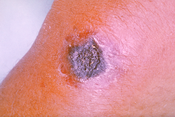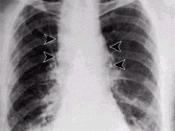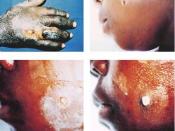Isn't That a Rock Band?
Anthrax in recent times has become very well publicized in this time of uncertainty. With the threat of terrorism lingering, anthrax has been documented in its use as a biological warfare agent (Fox 1). The following will discuss what type of disease anthrax is, the symptoms of infection, what is occurring at the cellular level to cause the symptoms and possible treatments available to counteract anthrax effects.
"Anthrax also known as splenic fever, malignant pustule or woolsorter's is a contagious disease of ectodermic animals (including humans) caused by the bacterium Bacillus Anthracis" (Swiderski 23). Bacillus Anthracis can form spores that are highly refractive to light and resistant to staining. "There are three types of anthrax: coetaneous ("skin"), gastrointestinal ("stomach") and inhalational ("lungs"). Cutaneous anthrax, most (about 95 percent) anthrax infections occur when the bacterium enters a cut or abrasion on the skin, such as when handling contaminated wool, hides, leather or hair products (especially goat hair) of infected animals."(Todar
2 and Ramierez 13) Skin infection begins as a raised itchy bump that resembles an insect bite but within one to two days develops into a vesicle and then a painless ulcer, usually 1-3 cm in diameter, with a characteristic black necrotic (dying) area in the center. Lymph glands in the adjacent area may swell. About 20 percent of untreated cases of cutaneous anthrax will result in death. Deaths are rare with appropriate antimicrobial therapy.
"Inhalation anthrax, initial symptoms may resemble a common cold - sore throat, mild fever, muscle aches and malaise. After several days, the symptoms may progress to severe breathing problems and shock. Inhalation anthrax is usually fatal" (White 98). "Gastrointestinal anthrax, the intestinal disease form of anthrax may follow the consumption of contaminated meat and is characterized by an acute inflammation...


